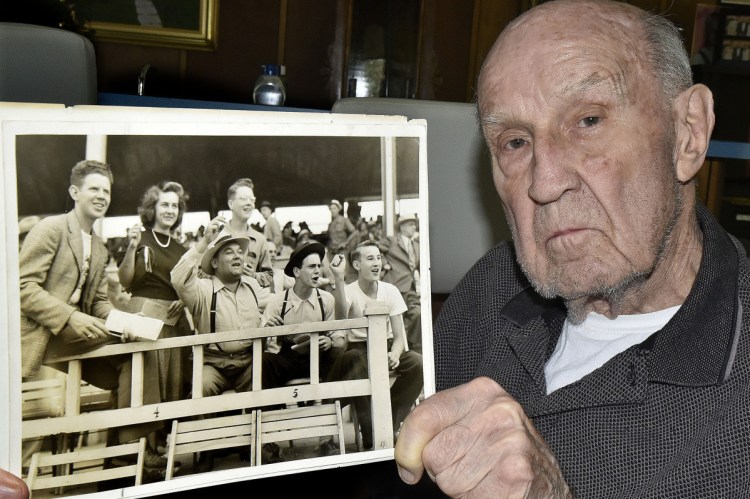NORRIDGEWOCK — There he is, a fresh-faced kid of about 13, cheering for a race horse from the old wooden grandstand at the Skowhegan State Fairgrounds, his fist raised in triumph.
It’s around 1935 and Don Eames, with a sharp new haircut, appears in the black-and-white photograph to not have a care in the world.
Who would? He was a boy on a summer afternoon at the fair.
“I think it was an ordinary day at the fair,” Eames, now 91, said of the photograph. “That was in the afternoon, so there would be racing going on in front of the grandstand. It was the high point of every kid’s summer to go to the fair. I was there every day because I worked there.”
Eames said he started working at the fair, cleaning the grandstand after events, when he was a little boy and worked in one capacity or another for 80 years, from president of the fair to the secretary for 40 years. The exhibition hall for the Skowhegan Fair Flower Show, built in 2001 just off the busy midway, is named for him.
The Skowhegan State Fair – the nation’s oldest consecutively running agricultural fair – was established in 1818, two years before Maine, then part of Massachusetts, became a state. The original organization was known as the Somerset Central Agricultural Society, a name that was used until 1942 when the official designation became the Skowhegan State Fair, according to the fair’s website.
This year celebrates 200 years of farm shows, livestock competition, garden exhibits, live music, harness racing, midway rides, fair food – and most recently, demolition derbies. The fair opens this year on Friday and runs through Sunday, Aug. 18.
Eames jokes that he doesn’t remember all 200 years of the fair, but he’s got 80 years of memories to tap into.
“In that grandstand, every seat was numbered,” he said, noting that patrons sat in wooden chairs to watch harness racing and live entertainment shows. “Because of that, you used to have ushers who were young ladies, young girls, who took you to your seats and who loved to work there and have a free pass. We paid them 50 cents for the evening and 50 cents for the afternoon – a dollar a day. So many young girls wanted to work there.”
Eames said the ushers went the way of history after the old grandstand and Constitution Hall burned in an arson fire in 1999 and the wooden chairs were replaced in the new grandstand, mostly by metal bleachers.
“I started working at the fair when I was about 10 years old,” he said. “Between the afternoon and the night shows, we did the cleanup of the grandstand. That was my first job. I just resigned a year ago from the board of directors of the fair.”
Eames, who was married to his wife, Ruth, until her death in 2006, helped raise their three children – Susan, Samuel and Jonathan – while working as a trial attorney in Skowhegan. After a stint in the Navy during World War II, graduation from the University of Maine and Boston University School of Law, he went to work in 1952 at his father, Clayton’s, law firm.
He later partnered in practice with Dick Sterns, Rob Washburn and Peter Barnett.
He says he remembers the old days at the Skowhegan fair when the midway was unpaved bare ground, the tents were made of canvas and the nightly grandstand entertainment was booked by a New York City talent agency.
“The fair back then was a great deal different,” he said. “In the afternoon, they ran harness racing, always, and in the evenings they had a nice show – singers, acrobatics, dance revues, entertainers like the (Flying) Wallendas, they were there.”
The fair also ran the Miss Maine Pageant from 1948 to 1960, along with “freak shows” of human and animal deformities and oddities, including a midget village, the World of Mirth Midway and burlesque-style “hoochy-koochy” shows.
“We had girlie shows in those days,” he said. “They would take off quite a few clothes – not everything. All the young guys went, of course. It was popular, but we got away from that. There are better things for people to see.”
“The night shows were well attended. Every night we had fireworks,” he said. “It’s changed over the years. The rides are somewhat different and it’s more expensive. Of course we had the Ferris wheel and the swings and the bumper cars, all for a couple of bucks.”
He said one of the major events at the fair has always been the harness racing, and the breaking of the two-minute time of a race was an important milestone.
Eames said Skowhegan paid better purses for race winners than most other racetracks and attracted better horses. He said he was close friends with the late S. Kirby Hight, whose father, Walter, had race horses.
Kirby Hight’s son, also named Walter, and Walter’s business partner, fair President Tom Dillon of Anson, owned Postcard Jack, a horse that retired at age 14 in 2004 as the top horse in Maine history, with the most finishes of less than two minutes and the most wins at 77 in 324 starts.
Livestock competition events and demonstrations also were different back in the old days, Eames said.
“Like everything, they’re bigger and stronger nowadays,” he said. “Everybody knows more about diet and nutrition – for you and me and the horse and the cow.”
As for the 1930s photo of him, Eames said he doesn’t recall the people’s names, but he remembers that day and those times.
“The fair has been a big part of my life. I hope it goes on forever,” he said.
Doug Harlow can be contacted at 612-2367 or at:
dharlow@centralmaine.com
Twitter:@Doug_Harlow
Send questions/comments to the editors.




Comments are no longer available on this story